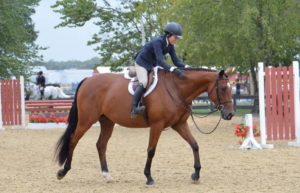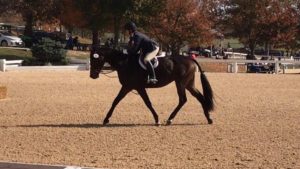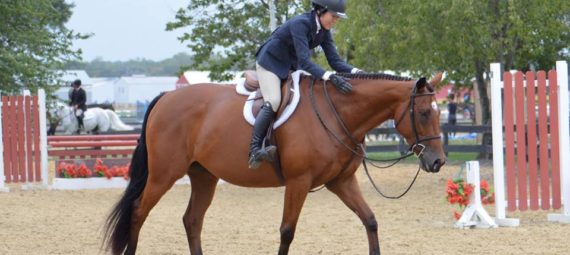It’s fascinating how many opposites there are in riding, both physical and mental. So many times, riders need to be good at seemingly opposite skills, at the same time, or nearly the same time. Too much of this or that, and the moment of awareness or brilliance is lost. Here are some of the paradoxes I’ve been pondering:
Tension vs. Relaxation

Riding requires a unique set of physical skills.You need to be able to be tight in the right spots, and soft in others. For instance, most riders want and need a strong leg. It can be used for pushing a lazy horse, making a lateral correction to an inaccurate track, or quieting a leg that wants to swing on a sensitive horse’s side. But there is also the need to relax, to follow, to allow, to just be, so we can let the horse carry himself, when he is going in the direction and speed we want. The firmness of our aids needs to be balanced by the silence of our bodies, so we can correct when needed, and reward (yield) when required.
Sometimes we need to do both at the same time. Hold with the leg, maintain a taught lower back, give with the elbow. Follow with the seat, while keeping a contact with the mouth, so the horse connects from hind end to front, without a hint of resistance. It’s a ballet of movements which are meant to be invisible to onlookers. Difficult to produce, but always worth the effort.
Urgency vs. Calm
To ride well, you need to be peaceful. There’s no place for negative emotion when working with horses. You can be firm, and have clear boundaries, but once anger or desperation sets in, you cannot fix the problem. On the flip side, you need to be able to react swiftly to your horse’s actions. If he’s falling in around a turn, that requires a quick correction with your inside leg to hold him out, but without tension or worry from you. If your horse is distracted by a car that’s close to the ring, you need a swift half-halt to get his attention back to you. How about when he’s spooking? You have to be fast to correct AND reassure him so he can relax and get past the issue, or you’ll make it worse.
Confidence vs. Humility
You can be confident and humble at the same time. Your horse needs to believe that you know what you’re doing. Sometimes you won’t have the answers, but if you react fairly and with an evenly matched response in each “conversation” you have, he will trust you in the times you are less certain. Confidence in your responses to what your horse is tell you is important for a successful ride.
Humility comes from knowing you don’t have all the answers. Horses teach us every day. Anyone who thinks they’ve learned all they can in riding is missing the amazing nuances of communication we can learn from working with our equine partners. “Pride goeth before a fall.” Call it karma or something else, we all know someone who thought they knew everything about horses, only to be proven wrong, sometimes in catastrophic fashion. We always have to keep in mind that these are animals who sometimes have unpredictable responses, and keeping an open mind to learning new ways to communicate with them is a great way to continue the progress.
Caring vs. Letting Go
I have some riders whom I wish would care more, and some who care too much. Neither extreme is a positive. I see many riders who have the physical talent to develop into greats, but they don’t have the desire to put in the time for the day-in, day-out practice that it takes to develop mastery of their bodies and their timing. Or, they have the faulty belief that what they do is “good enough,” and they don’t feel they need to work harder to: get stronger, improve their half-halt, ride the horse straighter, hold their position longer over the jump, look sooner in the air, keep their leg consistently underneath their hip, tip their thumb up to get an elbow in, stop hanging on the right rein, or [insert any riding flaw here]. What they feel as they are going around feels okay, and that’s enough (it’s a rare student who feels this way, but they exist). Conversely, I also see riders who want to improve so badly that they drill their horse to the point of irritation, fatigue or pain, in addition to always wanting to jump One. More. Jump.
Now, not every rider does either of these, but I’m certain that every rider out there has been on one side or the other. How do we learn to swing back toward the center? Moderation.
MODERATION
In all of these “opposite” issues, the key is moderation. Some of both is good. You need some tension (firmness) and some softness. You need confidence and humility. And you definitely need to care and not care. You need to commit to improvement – spend time in the saddle, really want to squelch that bad habit that is holding you back, and you need to give yourself permission to make mistakes, and know that you will always have another try to get it right.
 Bad Times Can Have Positive Outcomes
Bad Times Can Have Positive Outcomes
I have a student who’s horse is currently laid up with an injury. She’s been riding my horses for a couple of months, and during that time, she has committed to fixing her hands over the jumps. Her lessons are not exciting. We’re not jumping big jumps or riding technical exercises. My instructions are generally the same from lesson to lesson. I’m her eyes on the ground, correcting her when she needs it and re-affirming when it’s right. She’s starting the feel the difference, so now she knows when she’s in the sweet-spot – with her hands half-way up the neck, pressed on the crest – instead of cursing herself for getting it wrong. There’s some good progress. I’m sorry that her horse is out of work, but I’m really glad that there’s some good that comes from the riding she’s doing right now. Her horse will appreciate it when she’s back in work, too. So this time is not lost. No time in the saddle is wasted, if you’re open to doing the work.
OTHER EXAMPLES
There are tons of opposites in riding. Here are a few others I’ve come up with:
-Holding versus allowing – Shorten the stride, but don’t stymie it altogether
-Problem solving versus spontaneous, instinctive responses – “Analysis paralysis” leads to an inability to react with the appropriate timing.
The swifter you respond with the appropriate aid, the quicker your horse gets back to doing what you want him to do. Can you think of other opposites in riding? I’d love to hear from you!



Great post! These are yet more examples how, to me, riding mimics life. In riding and in life we need to be soft yet strong, urgent yet calm, confident yet humble, and so on and so forth. An “opposite” that comes to my mind is thinking vs. overthinking. As riders, we need to always be thinking (whether it’s about where our leg is, where our hand is, where the next jump is, etc), but not overthinking. Sometimes we overthink things to the point that we get in our own way of being good or even improving whatever we’ve been working on. Or we overthink something so much that we create worry, and therefore create other issues. We need to trust in our training and our horse and be thinking about what we’re doing, yet not overthink it. Tricky business!
So true! Thanks for your comments!
Add leg while asking your horse to collect! My current horse is an ex-jumper that I am trying to convert to a hunter. I need to remember that when he gets strong I can’t just pull. I need to pull and leg to get the right pace. Ugh
…And then remember to let go again! Great comment, thanks, Rachel!
Great post! So many good thoughts about balancing opposite things while riding. I agree also with the commenter above who said thinking vs overthinking. That resonates with me, as I often can try very much to get something right and I overthink it. When/if I later get a chance to do something else (e.g., do a pattern, or do serpentines,etc) my thinking about the pattern will free up my mind about the specific thing I was trying to do, and I will get it!
Another one that comes to mind as well is my needs vs the horse’s needs, on a given day. Sometimes I can go with my needs, other days I must focus on just the horses needs. Lots of balancing in the horse world. Your article is wonderful!
Thank you!!